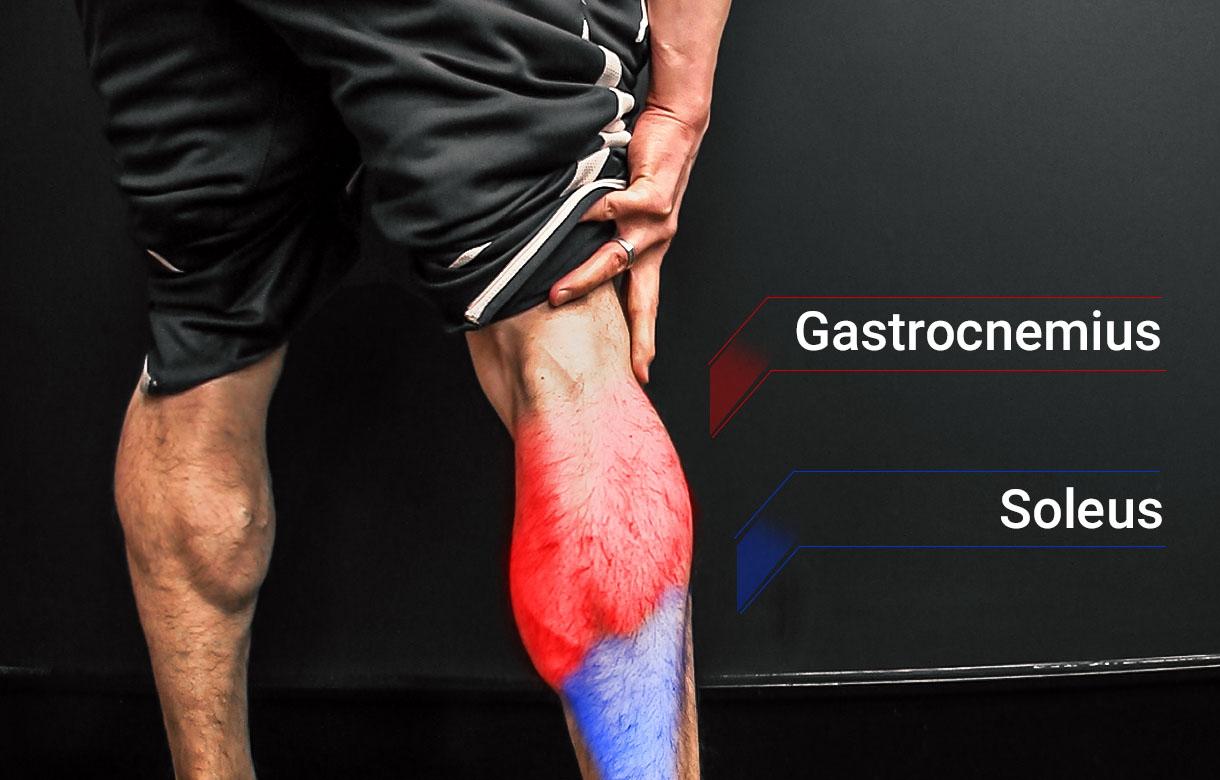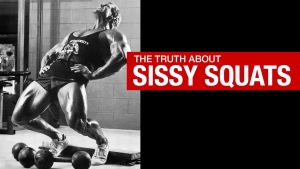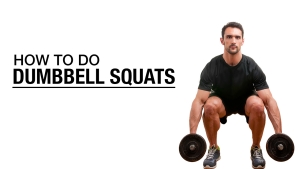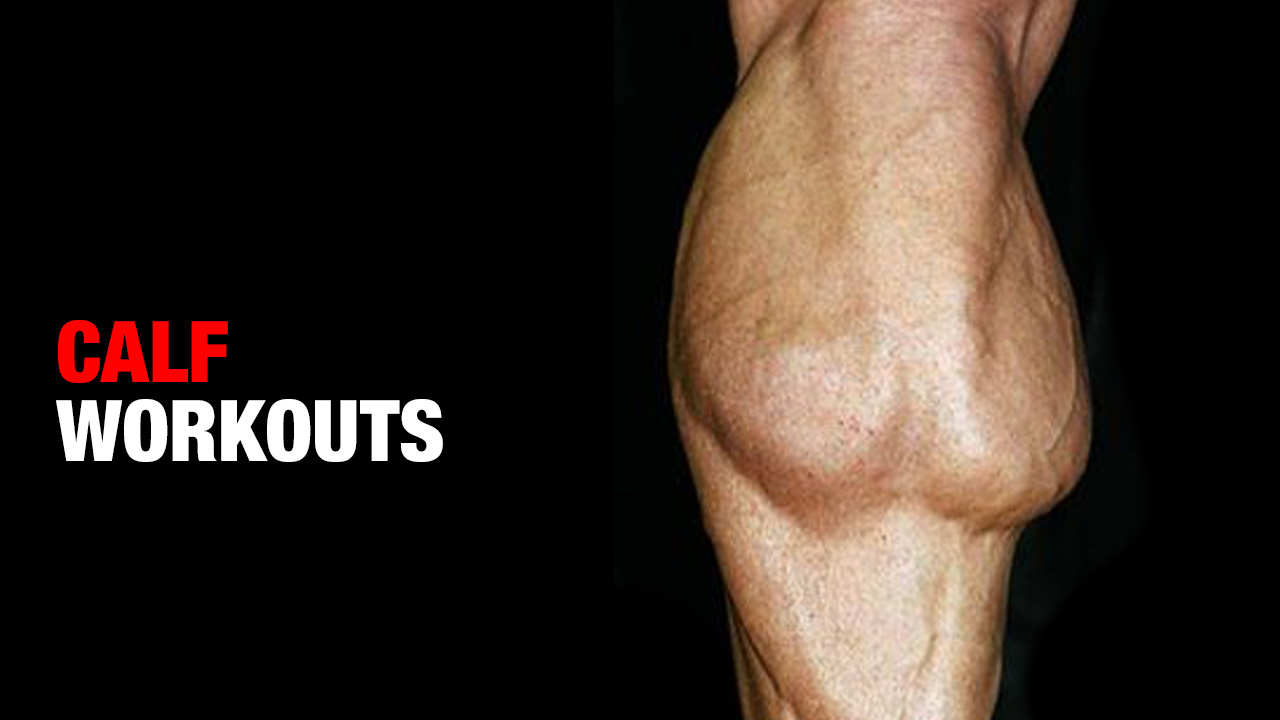
THE ULTIMATE CALF WORKOUT GUIDE
Have you ever wondered whether specific exercises for calf muscles are truly essential in your workout routine?
And if they are, do simple Calf Raises get the job done?
As a physical therapist and strength coach, I see too many folks bypass calf exercises, assuming their leg workouts provide sufficient work for these muscles.
Unfortunately, this approach isn’t going to hit the bullseye if you’re after bigger and more defined calves.
To truly unlock the full potential of your calf muscles, you’ll need to engage these muscles with the best calf muscle exercises.
In this all-inclusive guide to calf workouts, I’ll lead you through the intricacies of calf muscle anatomy and crucial elements to incorporate into your calf training.
I’ll also cover excellent calf exercises and workouts to promote growth in your calf muscles!
Here’s what I’ll be covering in this calf training guide:
1) CALF MUSCLES ANATOMY
Understanding the leg muscles you’re trying to develop is the key to optimal results.
I probably sound like a broken record, but you need to spend time developing a strong mind-to-muscle connection if you want to build strong calves.
The more connected you are with your calves, the more you can get into the muscle, which is necessary for calf development.
So, before I break out this effective calf workout, I want to make sure you understand the anatomy of the calf muscle.
The calf region of your leg consists of two primary muscles that perform a variety of lower body functions.
These two muscles are the gastrocnemius and the soleus. Let’s dive deeper into each.
GASTROCNEMIUS
The gastrocnemius is usually what you think of when someone mentions the calf muscle.
It’s the largest calf muscle and it’s the more visible calf muscle of the two. It’s the one that gives your calf its characteristic bulging, muscular appearance.
The gastrocnemius has two bands of muscle fibers or ‘heads’ – the medial head (on the inside of the leg) and the lateral head (on the outside of the leg).
It assists in bending the knee, but its primary role is pushing off the ground when we run, jump, or walk.
It’s particularly engaged when your knee is straight, and you lift your heel off the ground, as when walking on tiptoe or jumping.
Exercises that take this muscle through a complete range of motion include Donkey Calf Raises and Toe Touch Farmer’s Walks.
SOLEUS
The soleus is a flatter, longer muscle located beneath the gastrocnemius and it’s most active when your knee is bent.
Its main function is to flex the foot downward (plantar flexion), playing an important role in activities like standing, walking, and running, particularly over long distances or periods of time.
It helps keep us upright when we stand and propels us forward when we walk or run.
To target the soleus muscle and build athletic calves, I’m a fan of Calf Launchers.
2) WHAT IS THE BEST CALF WORKOUT?
Now that you’ve spent a few minutes in front of a full-length mirror flexing your calves, we can talk about the best calf exercises.
Guys, it’s not just about which calf exercises you do, but how you do them.
Remember, it’s always about quality, not quantity.
Since the calves are tough and resilient muscles, you’re going to want to shoot for at least 15-20 reps for each set.
But here’s the thing, these reps need to be intense.
You need to take the muscle through a full calf range of motion and use progressive resistance.
As far as training frequency, you should be hitting your calves twice per week in addition to your normal leg workouts.
And you need to move through this range with the right exercises.
Spoiler alert: Seated Calf Raises or anything on a Leg Press machine aren’t on this list! Using calf exercise machines like the calf press machine isn’t the best way to get the benefits mentioned above.
Here are the exercises that I would recommend for an awesome calf workout, complete with exactly how to perform them.
Try adding in 2-3 calf exercises during your usual workouts. If you perform all of these exercises, you’re looking at a 25-minute calf workout in total.
DONKEY CALF RAISE


HOW TO DO THE DONKEY CALF RAISE:
- Get started by positioning a weight plate on a weight belt around your waist.
- Stand in front of a secure step or an elevated surface. Standing on the step with your toes, let your heels extend off the edge and assume a nearly horizontal posture by leaning forward from the hips.
- Start the exercise by slowly lowering your heels, triggering a deep stretch in your calves.
- Follow this by lifting your heels as high as possible, focusing the contraction by moving the balls of your feet and giving your calves a firm squeeze.
- Return your heels to the initial position to complete a repetition.
- Take this one to failure, especially if your goal is muscle hypertrophy.
WHAT MAKES IT EFFECTIVE: I see a lot of people doing these on the Donkey Calf Raise Machine, but I think you’ll get more out of these calf raise variations. Placing the weight plate behind you allows you to deepen the active stretch and contraction in the calf muscles. This one will help you build seriously stronger calves.
SIT-TO-STAND CALF RAISE


HOW TO DO THE SIT-TO-STAND CALF RAISE:
- Place a pair of dumbbells on the floor in front of a wall.
- Put a stability ball against the wall and lean against it. Make sure you’re in standing position on a flat surface with feet hip-width apart.
- Squat down into a bent-leg position to pick up the dumbbells. Stand back up and fix your form, making sure you maintain a tight core.
- Now, go down to a straight angle, into a bottom part of a squat position, and start with the soleus lift. That means you’re going to bend your knees and move your heels up.
- Go as high as you can and then straight out with your heels flat. This is a great way to build up your calves since you’re able to use heavy weights here.
WHAT MAKES IT EFFECTIVE: By bending the knees, you can primarily target the soleus muscle – the part of the calves that doesn’t get nearly as much attention as it deserves.
TOE TOUCH FARMER’S WALK


HOW TO DO THE TOE TOUCH FARMER’S WALK:
- Holding a pair of dumbbells, get on to your tip toes. Make sure your core is tight and your shoulders are back.
- Now, staying on your tip toes, walk across the room.
- Once you get to the other side, let your heels come down, turn around, and walk back again on your tip toes.
- You can also do these with a looped resistance band but you really need to take your time moving down the floor since you don’t want the band to come up and snap on you.
WHAT MAKES IT EFFECTIVE: This is an excellent way to fatigue the calf muscles, which are notorious for being super resilient.
DUMBBELL CALF HOPS

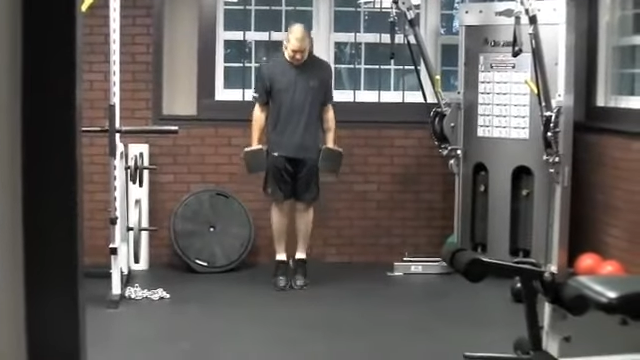
HOW TO DO DUMBBELL CALF HOPS:
- You can think of this one like a jump rope with lighter weight. Start by standing, feet hip-width apart, with a dumbbell in each hand.
- Shift weight onto the balls of your feet, then hop up, extending ankles and engaging calves at the peak.
- Land softly, with bent knees, then hop again.
- Make sure to maintain stability by keeping your abs tight and back straight. An adjustable dumbbell makes this exercise easier if you need to quickly reduce weight, but you can also wear a weighted vest.
WHAT MAKES IT EFFECTIVE: Calf hops effectively strengthen and tone the calves, improving endurance, balance, and athletic performance.
1-½ CALF RAISES

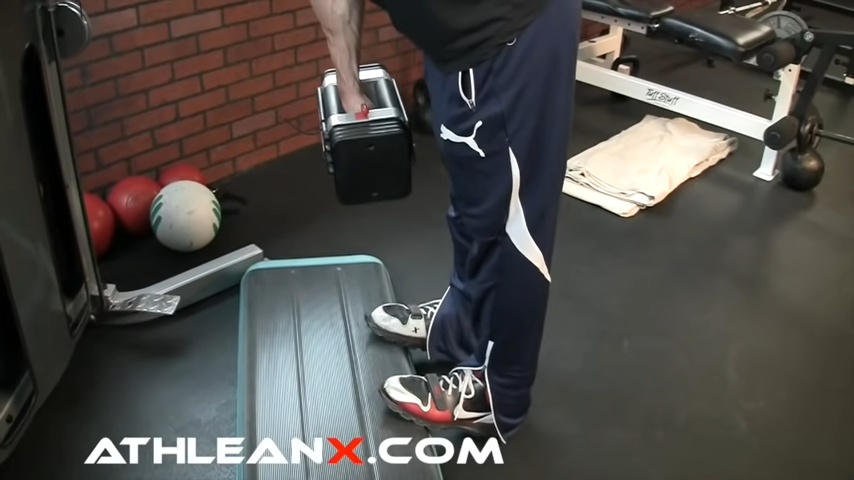
HOW TO DO 1 1/2 CALF RAISES:
- The 1½ Calf Raise is a variation of the standard Standing Calf Raise. It requires a dumbbell and an elevated platform or step. Your toes should be forward on the platform edge with feet shoulder-width apart, allowing a forward lean for a full knee extension.
- Begin with heels down and ankles under your knees to deliver an active stretch to your calves.
- Support yourself on a stable object, keeping the dumbbell in line with the center of your body.
- Press up halfway, lower back, press all the way up, then lower down. This gives two contractions per rep, which means a ton of time under tension.
WHAT MAKES IT EFFECTIVE: Since you get two contractions per repetition, you’re going to cook your calves! You’ll be targeting the entire calf muscle while stretching out the hamstring.
SINGLE-LEG CALF RAISES


HOW TO DO SINGLE-LEG CALF RAISES:
- Start by standing upright with a heavy dumbbell, shifting your weight onto one foot. For stability, you might need to hold onto a wall or another sturdy object.
- With your core engaged and your gaze directed forward, raise your heel off the ground as high as possible by pressing through the ball of your foot.
- At the peak of the movement, pause briefly to feel the contraction in your calf muscle.
- Then, control the downward movement as you lower your heel back to the ground. If you start on the right foot, be sure to do a set on the left foot.
WHAT MAKES IT EFFECTIVE: Learning how to do Standing Calf Raises on one leg at a time is highly effective due to the ability to isolate each calf muscle, address imbalances and improve strength, endurance, and flexibility.
3) HOW TO DO CALF WORKOUTS AT HOME
Whether you’re pressed for time, prefer the comfort of your own space, or lack access to a gym, doing calf workouts at home is both convenient and effective.
The beauty of these bodyweight calf exercises is that they are adaptable to all fitness levels and can be easily integrated into your daily routine.
They allow you to build strength, flexibility, and endurance right from home.
Here are my picks for the best calf workouts at home:
CALF LAUNCHERS

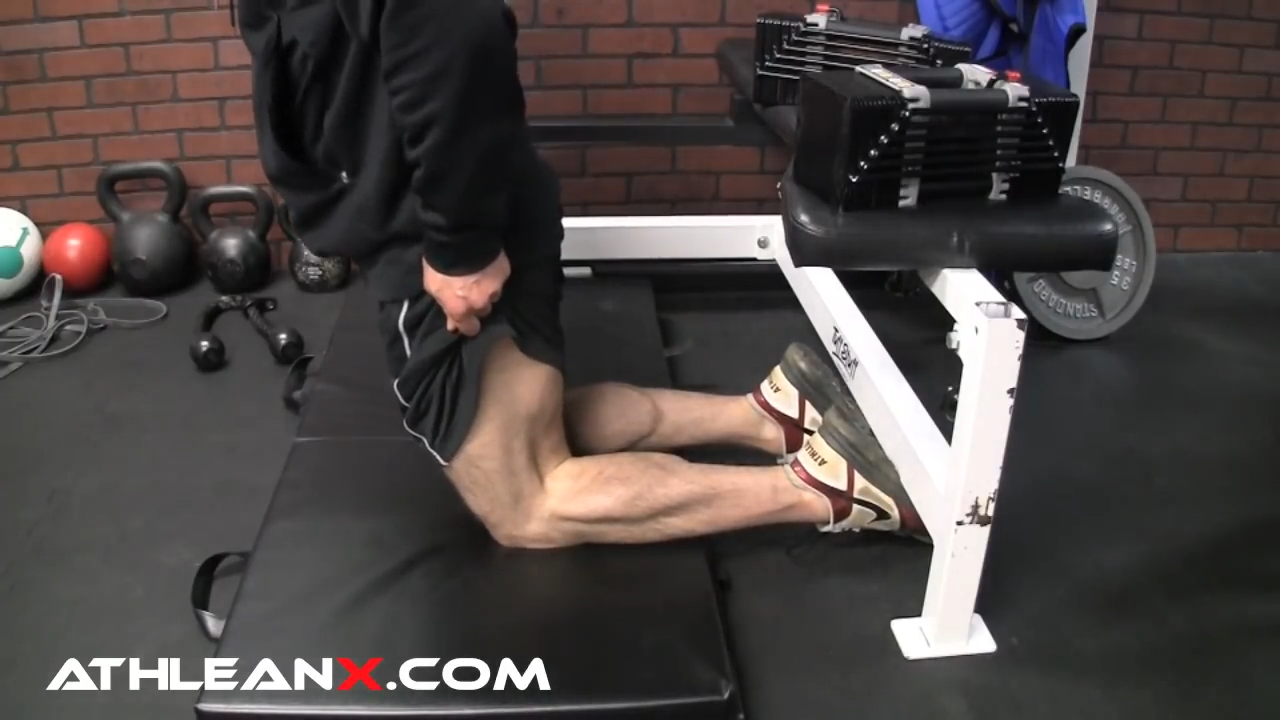
HOW TO DO CALF LAUNCHERS:
- Start by securing your feet flat under a bench or couch, lifting your heel, and flexing your feet to maintain an upright position, ensuring an immediate calf contraction when set up correctly.
- Initiate from a seated position with your buttocks resting on your heels.
- To ignite your calf muscles, gradually propel your body forward, leaning with an engaged core, as demonstrated in the exercise.
- Use the range of motion needed to activate your calves; even a smaller range is acceptable if it effectively stimulates these muscles. Keep in mind that you can use a stability ball here to assist you.
WHAT MAKES IT EFFECTIVE: This exercise will make your calf muscles work harder than any other exercise you’ve tried before. For instance, lifting heavy weights won’t challenge your calves as much as you might think because when you walk, you already carry all your body weight on one leg at a time. This isn’t something new or unheard of. But trust me, the exercise I’m showing you will really work your calves!
SPRINTER CALF RAISE

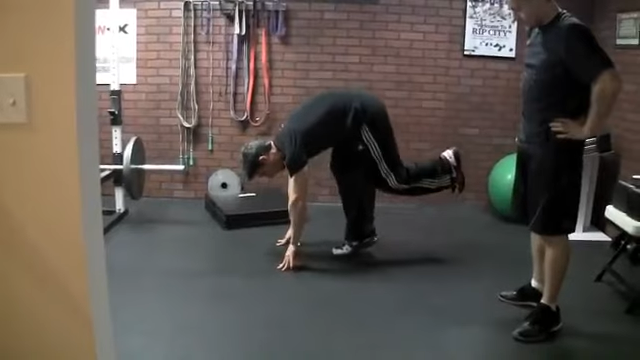
HOW TO DO THE SPRINTER CALF RAISE:
- Get down into a sprinter position. You want to make sure the knee is bent, and the soleus is engaged.
- Push straight up through the ball of your foot and then also push the knee back. In order to be able to get that calf to fire, you want to get your knee as straight as possible.
- Contract the calf muscle and slowly bring yourself to the starting position.
- Be sure to do an equal number of reps on both sides of the lower body.
WHAT MAKES IT EFFECTIVE: Sprinter Calf Raises work the calf muscle through its full range of motion while forcing a deep stretch through the hamstrings.
SPRINTER CALF JUMPS

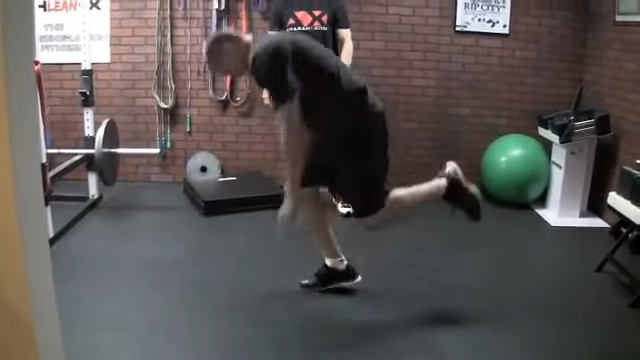
HOW TO DO SPRINTER CALF JUMPS:
- Assume the same form and starting position as the Sprinter Calf Raises. Instead of simply raising the calves up, you’re going to do an explosive movement.
- Push through the calves, exploding up into the air.
- When you land, do so softly and focus on the calf muscle to decelerate the movement. Make sure you maintain perfect form and that you’re stable before moving into the next rep.
- Again, repeat this exercise on both sides of the body to complete a set. If you don’t have great ankle flexibility, you might want to build up to this one as it does require strong ankle joints.
WHAT MAKES IT EFFECTIVE: This plyometric exercise is fantastic for developing explosive power in the calves. Very useful for plyometric training and improving athletic performance.
HOW TO DO SINGLE-LEG STEP RAISES:
- Find a step in your home where you can hold onto a rail or wall for balance for the entire movement, if needed.
- Starting position is standing on the edge of the step with one foot, allowing your other foot to hang free or resting it on your working ankle. Your heel should be slightly lower than the step to start.
- Engage your core and slowly raise your body by lifting your heel as high as you can while pressing through the ball of your foot. You’ll feel a contraction in your calf muscle at the top of the movement.
- Control your descent back to the starting position. This is a great beginner exercise if you have calf mobility issues.
WHAT MAKES IT EFFECTIVE: Performing Bodyweight Calf Raises on a step allows you to fully stretch out the muscle, making for a more intense contraction and building calf strength. It’s also great for calf flexibility. Don’t forget to hold the contraction at the top of the exercise.
4) HOW TO GROW YOUR CALVES
Are you happy with your quads and hamstrings, but you think your calves could use some work in the size and calf thickness department?
If you want to learn how to get bigger calves, you might be surprised to learn that you will want to focus on more than just the gastrocnemius.
For hypertrophy, you want an exercise that hits the soleus harder than the gastrocnemius. Why is that?
Remember how the soleus sits beneath the more visible gastroc?
When you build up the soleus, it will push out the gastrocnemius adding more size and definition to your calves.
At the same time, you don’t want to ignore the gastrocnemius completely. So, is there an exercise that hits both with an emphasis on the soleus?
You bet.
CALF LAUNCHERS


Calf Launchers require an immediate and intense contraction from both the soleus and gastrocnemius muscles in your calves. You’ll experience constant tension throughout the exercise.
Bending your knee at the start of the exercise works your soleus muscle more. As you straighten your knee, you’re engaging more of your gastrocnemius muscle.
If this exercise is too much at first, you can regress the difficulty with a stability ball. Put the ball out in front of you to assist you as you extend forward.
5) BEST SHORT CALF WORKOUT
All these calf workouts sound great but what about if you don’t have much time or equipment?
Maybe you’ve got a fraction of the time you normally do for a workout, but you want to do something. Is there a way to target your calves in an effective way in minimal time?
Of course, there is!
Do you have about six minutes to exercise? Then you have time to work out your calves.
Here’s my 6-minute calf workout for those of you who are always on the go.
A quick note for those with shaky ankle stability, I’d recommend holding onto a wall for balance. Once your ankle stabilization improves, you should be fine to do without the wall.
SIX-MINUTE CALF WORKOUT
You’ll continue switching between the two exercises until the full six minutes have elapsed, or until the discomfort becomes too much, whichever happens first.
Each exercise will be performed three times.
Every time you perform the Calf Raise, adjust the direction your toes and heels are pointing.
During the first round, you’ll keep your toes pointing straight ahead.
In the second round, turn your toes outwards, and then point them inwards in the third round.
Make sure to stand with your feet no wider than shoulder width apart and keep your legs straight, aligning your hips, knees, and ankles.
And don’t forget, you can use an exercise ball to help balance and support some of your weight during the Calf Launchers.
ROUND 1
Perform the Calf Launchers exercise for an entire minute, then without delay, switch to doing 1-½ Calf Raises with your toes pointing directly forward.

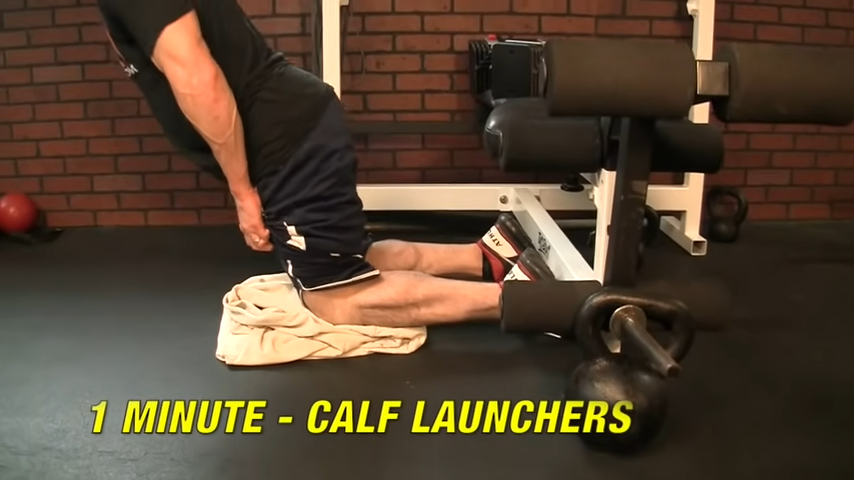

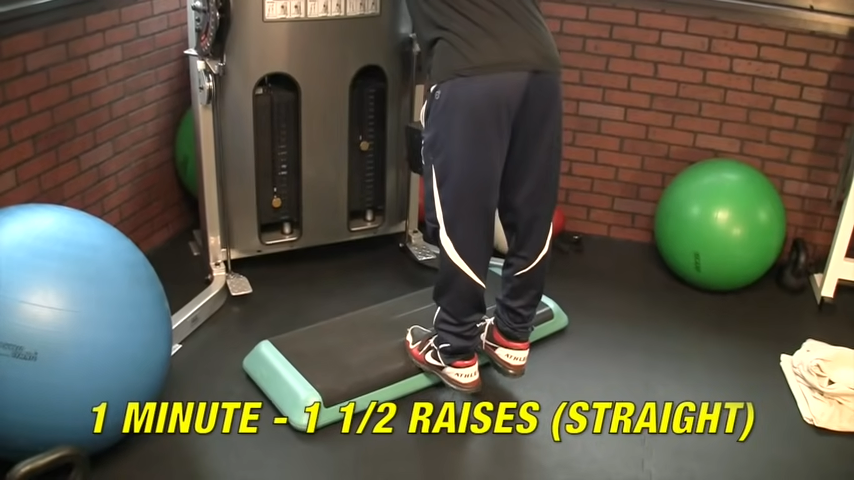
ROUND 2
Again, perform Calf Launchers for a full minute and then immediately jump over to 1-½ Calf Raises. This time, make sure that your toes are pointed outward.




ROUND 3
Finally, perform the Calf Launchers exercise one last time for a full minute. Just like before, go right to 1-½ Calf Raises with toes pointed inward.



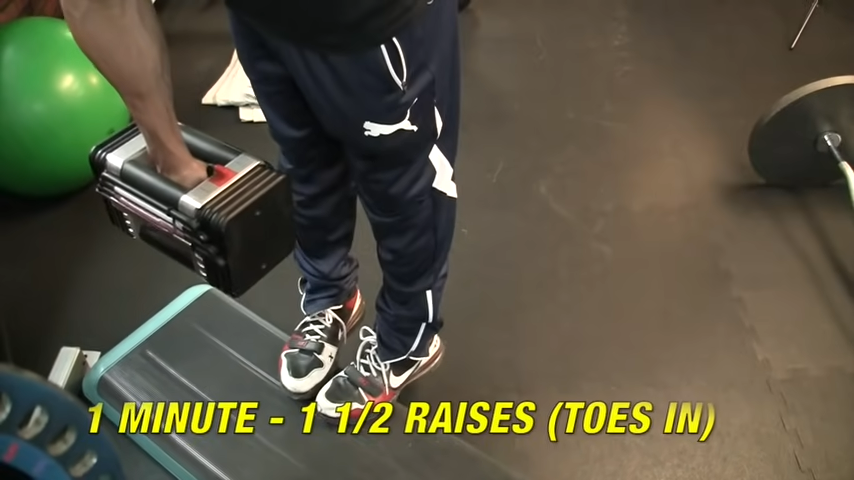
Thanks to the calf muscle fiber type, the calves can be some of the most stubborn muscles on the body, even with great lower body strength. But they also have great hypertrophy potential.
If you hit them right and hit them hard with quality reps, you’ll see size, strength, and shape in no time.
Remember, guys, focus on perfect form and high-intensity contractions in order to push your calf muscle growth and gains to new heights.
If you’re looking for a complete training program to build lean muscle and strength in every muscle group in the body and improve your physique, see which of our ATHLEAN-X programs best suits your goals and equipment possibilities.
CALF WORKOUTS FAQ
The best exercises for calves should target both the gastrocnemius and soleus – the two muscles that make up the calves.
To primarily target the gastrocnemius, you can do 1-½ Calf Raises, alternating which direction the toes are pointing each set.
For the soleus, I’d recommend Calf Launchers.
These are the best exercises for building big, strong calf muscles.
The timeline to tone your calves can vary significantly based on factors like your current fitness level, the intensity and frequency of your workouts, and your nutrition and recovery habits.
Generally speaking, you may start noticing changes in your calves after 6 to 8 weeks of regular, focused calves exercises.
However, keep in mind that significant toning and definition can often take several months of consistent training.
Remember, the key to achieving your fitness goals is patience, consistency, and a well-rounded approach to your workouts and nutrition.
To train your calves at home with minimal equipment, I’d recommend the following exercises to build bigger, stronger calves:
For calf muscle mass, focus not only on the gastrocnemius but more on the soleus muscle beneath it.
The benefit of calf training the right way is a better development of the soleus, which enhances the gastrocnemius' size and definition.
However, an optimal workout should still include exercises that target both muscles, primarily emphasizing the soleus.
I’d recommend Calf Launchers if you want to bulk up your calves.
To get bigger calves in 30 days, you’ll want to incorporate calf exercises into your routine that build up the soleus so that it pushes out the gastrocnemius.
I’d suggest pairing Calf Launchers with 1-1/2 Calf Raises.
Perform Calf Launchers for a full minute then switch to 1-1/2 Calf Raises, making sure to alternate the direction of your toes each time.
Yes, you can grow your calves. Like any other muscle group, the calf muscles can be developed and enlarged through consistent and targeted exercise, along with proper nutrition and adequate rest.
As far as exercises go, focus on calf workouts that target both the soleus and gastrocnemius muscle fibers.
Pairing exercises like Calf Launchers, Donkey Calf Raises, and Sprinter Calf Jumps can develop strength, power, and size.
Growing calves can be tough due to their composition of different muscle fibers, with many having more growth-resistant slow-twitch fibers.
They're also used frequently in daily activities, making them less responsive to additional exercise.
Genetics also impacts calf size and shape. Nonetheless, regular targeted workouts can lead to growth.
Here are three exercises, each one targeting a specific part of the calf muscle:
Gastrocnemius Medial Head: Standing Calf Raises with Toes In
Gastrocnemius Lateral Head: Donkey Calf Raises with Toes Out
Soleus: Calf Launchers
How long it takes to build the calf muscle varies from person to person, depending on factors like workout intensity, frequency, diet, genetics, and overall health.
However, typically, you may start seeing noticeable results after 6-8 weeks of regular and targeted calf exercises.
The time it takes to grow your calves significantly is subjective and can vary widely.
With dedicated and regular calf-focused workouts along with a balanced diet, you may notice growth within about two months.
However, remember that genetics play a crucial role and results can vary between individuals.
REFERENCES

Jeff Cavaliere M.S.P.T, CSCS
Jeff Cavaliere is a Physical Therapist, Strength Coach and creator of the ATHLEAN-X Training Programs and ATHLEAN-Rx Supplements. He has a Masters in Physical Therapy (MSPT) and has worked as Head Physical Therapist for the New York Mets, as well as training many elite professional athletes in Major League Baseball, NFL, MMA and professional wrestling. His programs produce “next level” achievements in muscle size, strength and performance for professional athletes and anyone looking to build a muscular athletic physique.
















